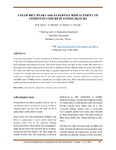| dc.description.abstract | Concrete paving blocks were first introduced in Holland to replace paver bricks which had become scarce due
to the post-war building construction boom. In Kenya, paving blocks are used in construction of pavements in
both residential and commercial areas. They can be used in areas with light or heavy traffic. Rice husks are a
byproduct of rice and its disposal has always been a challenge in Kenya. When the husks are burnt, they produce
rice husks ash which was used in this study as partial replacement of cement at 5%, 10%, 15% and 25%.
Compressive strength and water absorption tests were carried out. As the content of rice husks increased,
compressive strength decreased. At 5% and 10% replacement ratios, concrete compressive strength was
36.76MPa and 33.79MPa. which is suitable for use in light traffic areas. Water absorption increased as rate of
replacement increased. However, it was below 5% recommended by ASTM. | en_US |

